Welcome to Word Publishing Layout View
In my previous post, the focus of attention was our new Office 2008 User Experience. For this post, I will turn the focus to another area that I am deeply passionate about --- Microsoft Word 2008. At MacBU, many of us have the great fortune to work on multiple areas of interest. So when I’m not “pushing pixels” in our new Office UI, my other role is Lead Program Manager for Word for Mac. Together with my passionate and dedicated team, we’ve been hard at work on a feature that has been three years in the making. With this new post, I am pleased to talk about one of our latest labors of love --- the new Publishing Layout View.
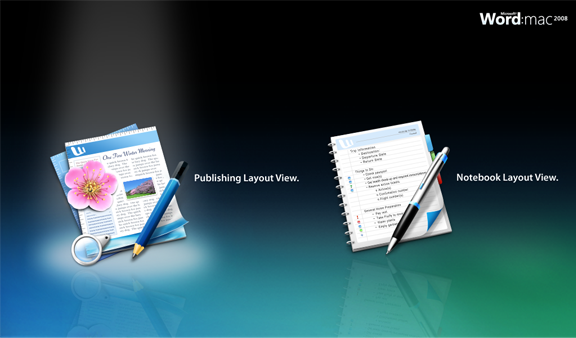
First, some background. For those using Word for Mac, you may already be familiar with Notebook Layout View from Word 2004. Notebook Layout View is a specialized notebook-like environment optimized for quick note-taking. By adopting the appearance of the familiar spiral paper-based notebook --- with notebook tabs and rule lines --- you can quickly capture thoughts and information as you would in an actual paper-based notebook. Notebook Layout View represented a new design philosophy in the development of Word for Mac. The premise of this new approach was to present a minimalist and “task-based” user interface in which 90% of Word’s typical UI is hidden and only exposing features relevant to the task at hand, in this case note-taking. Our customers have responded positively to this approach because the user interface is more approachable and less “bloated”, thereby making relevant features easier to find. I’m pleased to say that we’ve further streamlined and improved this popular feature in Word 2008, but that’s a subject for another blog post. :)
Now let’s fast-forward to Word 2008. For years we have known that Word is used to create a wide spectrum of documents that fall under two basic categories:
- Text-centric documents --- these include manuscripts, reports, resumes, letters, etc.
- Layout-rich documents --- these include newsletters, brochures, flyers, greeting cards, business cards, among others
Word has long provided a full complement of the features necessary for the creation of these two different categories of documents. However, given that all of such features were presented all at once with a single “one-size-fits-all” user interface, users found it difficult to find the right features for the right task.
Our previous efforts with Notebook Layout View allowed us to gain valuable insight and experience in crafting specialized working environments. By leveraging what we’ve learned from Word 2004, we set out to create Publishing Layout View --- a streamlined workspace optimized for creating professional layout-rich documents. By stripping away all the unnecessary controls in this special environment, we are able to elevate our desktop publishing-caliber tools with a greater level of cohesion, all without adversely impacting how users work in the standard view of Word. In this specialized environment, it's no coincidence that there is only one single horizontal toolbar, the Standard Toolbar --- in this case, less is more. Also, the basic metaphor of entering text is also markedly different --- text is entered through floating Text Boxes that the user can feely position anywhere on the page (and even off the page). No longer will text “get stuck” or “jump around” due to the properties of “inline text” --- which like the term itself --- is a mystery to anyone but the most advanced Word user.
In designing Publishing Layout View, we’ve taken a methodical approach to rethink how existing features work, and how to present them. Again, let’s take the most basic element --- the Text Box --- as an example. While Text Boxes in Word have long offered users the ability to establish connecting “links” between individual Text Boxes, it was neither obvious how to create such links, nor was it easy to determine the relative order of a linked Text Box within a “chain”. In Publishing Layout View, users can create a new linked Text Box directly from another Text Box. Also, at the moment a link is created, all Text Boxes within the new “chain” will pulse just once with a subtle blue halo to denote that a link has been created across the affected Text Boxes. When a link is broken, all Text Boxes within the chain will pulse with a subtle red halo to denote the chain has now been broken.

As shown above, to help users quickly identify the sequential ordering of linked Text Boxes within a document, we’ve provided a number badge that reveals the relative order when the mouse hovers over each Text Box. Moreover, given that complex layout rich documents like newsletter and brochures can have multiple Text Box “chains” within a document, Text Boxes are given color coded outlines (upon hover over) to indicate which “chain” it belongs to. These are just a few of the many new innovations we’ve added to Publishing Layout View.
What has made the creation of Publishing Layout View particularly exciting is that despite being the creators of the product, we are also target audiences ourselves. My first encounter with the Mac was during my high school days and the Mac introduced me to the power of desktop publishing --- while this was many many moons ago, this encounter left a lasting imprint on me. At the time, I was an editor-in-chief of one of my school’s student publications and I soon realized the amazing possibilities of desktop publishing even though the tools were still primitive compared to today’s standards. Yet years later, while our customers have been aware of Word’s powerful capabilities, many have not been able to fully tap these features and other dedicated DTP applications remain too high-end or intimidating for the majority of users. With Publishing Layout View, we were afforded with the exciting opportunity to go back to the drawing board and rethink how we could offer this powerful functionality with a more discoverable and intuitive user experience.
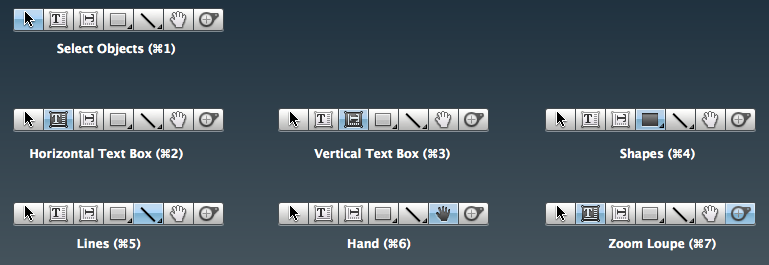
As noted earlier, by offering a specialized working environment, we can elevate our desktop publishing-caliber tools without affecting how Word looks and behaves in the standard view. In Publishing Layout View only, the single Standard Toolbar features a special toolset containing the most commonly used commands and elements used for layout-rich documents. Our popular Formatting Palette is also designed to expose advanced typographical features that have long lived in the depths of Word’s user interface, unknown to many users.
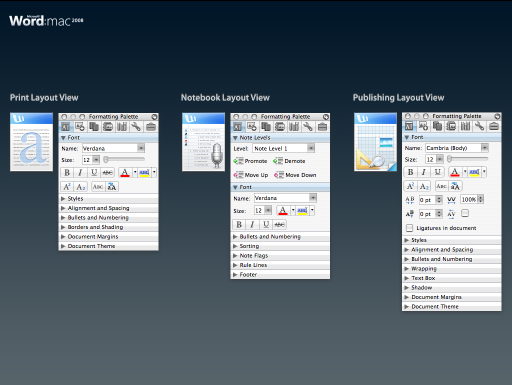
A new feature now accessible directly from Publisher Layout View’s Formatting Palette is the ability to turn on ligatures, allowing users to further tap the richness of many beautiful fonts on the Mac. From the first time I was introduced to ligatures back when Macintosh Classics were all the rage to the world of Intel-based Macs today, in between there was an emotional moment when I saw the very first ligature display on the screen inside Word.
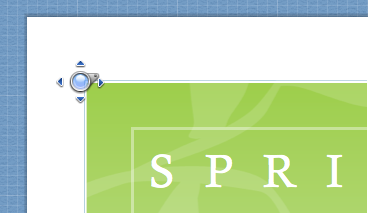
In Publishing Layout View, the keyboard combination of “Command + or –” now zooms in and zooms out as you would expect. However, we’ve you’ll also notice a new “Zoom Loupe” Tool. This is a new tool that allows you to target a specific area on the document, and then seamlessly zoom in and out with a single mouse movement. As quickly zooming in and out is one of the most common actions performed when creating a layout rich document, the Zoom Loup is a small but useful innovation that I wish I had many years ago (besides wishing that I could also travel back in time).
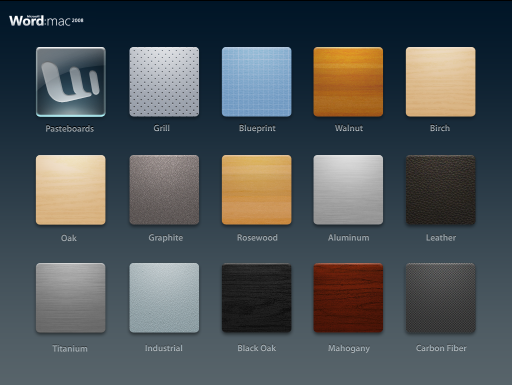
To capture the very essence of what is commonly referred to as “desktop publishing”, we also examined the concept of a “desktop” in the context of the overall workflow. In Word, the content of a document lives on a page --- and this page is set on a background surface much like a piece of paper is set on an actual desk. In Publishing Layout View, users can place layout elements such as text, pictures, and shapes on what we refer to as a “pasteboard” during the layout process. Given that we also know that one’s workspace is often highly customized to one’s own tastes, we provide 14 different customizable pasteboards --- all of which reflect our aesthetic vision through high fidelity and photo-illustrative examples of real world materials. These different pasteboards also ensure that there is sufficient visual distinction between “special-purpose” and “standard” Word views.
While there are a long list of noteworthy features, I would like to shift focus to the actual Publishing Layout View designer templates. I believe that the output capabilities of a product can be better demonstrated by a collection of professionally created designer templates than a long bulleted feature list.
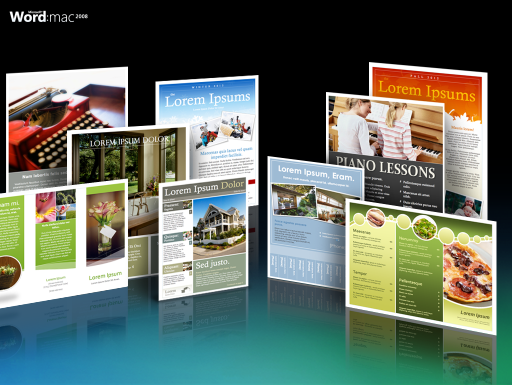
The planning and creating of designer templates started as early as product development started. I have always maintained that instead of having the application drive template designs, it should be the other way around. That is to say, let’s not develop the product first and then come up with a collection of templates as an afterthought. Instead, we should start with a strong vision, understanding, and appreciation of what great output looks like, and then build the product and features that enable that vision. If a feature is just added for the sake of adding features, but cannot be used in a meaningful or integrated manner during document creation, then it is of little value to the overall product, and most importantly, to our customers. Also, with Office 2008, you will not find a “bajllion” new templates --- instead, our focus favors quality over quantity and our bar is higher than ever.
Two decades ago, the world saw the debut of the revolutionary product known as the Macintosh. One of the hallmarks of the Macintosh was that it introduced us to a new world of “desktop publishing” which forever changed the typesetting and personal computer industries. One of the overall pillars for Office 2008 is “great looking documents made easy” and Word 2008’s Publishing Layout View is a cornerstone of this effort. I have found Word 2008 to be my new application of choice for layout-rich documents and it is my hope that you will find Publishing Layout View to be your new freeform canvas for your boundless creativity.
Comments
Anonymous
October 10, 2007
PingBack from http://www.artofbam.com/wordpress/?p=7069Anonymous
October 10, 2007
I would become gladly beta tester. Is that possible? Roland Koehler, Hamburg, Germany mail@roland-koehler.deAnonymous
October 10, 2007
In the next installment - Entourage!Anonymous
October 10, 2007
I'm not really sure if mixing word processing and layouting into the same programm is such a great idea (btw I think the same about Pages). Why didn't you just made a separate application, call it Microsoft Publisher:mac?Anonymous
October 10, 2007
How's this relevant to the Windows' Office? I don't see it any relevant to it. Well, I guess I should deinstall my Office for the Mac and try to use NeoOffice or iWork to have a consistent interoperability between using Windows Office.Anonymous
October 10, 2007
Wait, I forgot something: these features seem to be more of a Publisher kind of thing... has Microsoft not thought of making a Publisher for the Mac? Guess not.Anonymous
October 11, 2007
Wow this looks very familiar...Anonymous
October 11, 2007
Your work is a real pleasure to witness. It proves that even in a very large project, change can happen when there is vision. Well, the devil's in the details, and users don't want only features, they want a fast and intelligent experience. We'll have to try out the actual product to see if plays as good as it looks. I do hope, though, that Office 2008 will put an end to some Mac users' dislike of the suite... Sometimes people get worried for me when I tell them I like Word. 'Hope that is going to change.Anonymous
October 11, 2007
Will Word be able to open Publisher files? At present, those files are a real pain in the neck for Mac users. ---Tim ArcherAnonymous
October 11, 2007
Looks great, especially for users of Pages at home and want similar functionality at work. However, the lack of Entourage news is deafening.Anonymous
October 11, 2007
This is really exciting. I used to have to go in and customize all of my toolbars in order to have the tools I wanted/needed in the places I wanted them for the common work I did. This takes care of having to tweak toolbars all the time! For years I have been frustrated by trying to layout documents in Word...perhaps now, no longer!Anonymous
October 11, 2007
Thanks for the heads-up. You're making many useful advances for publishing tasks. I'm hopeful that more imaging management advances will be coming. As a professional editor with 32 years experience my evolutions has been as follows: Smith Corona & fingers Commodore & Paperclip IBM PC & Wordperfect IBM PC & Word (forced out of Wordperfect by IT dept) Mac & Word As for editing and writing, I miss Wordperfect and am ever hopeful for a more perfect Word. I still have to "clean" my Word text in a plain text software (like Text Edit) before submittal to art department for use in design software.Anonymous
October 11, 2007
Sounds great. Maybe now putting graphics into a word document won't be a frustrating experience. But why the silence on Powerpoint?? It would be nice if you could catch up to, or even pass, Keynote.Anonymous
October 11, 2007
Just WOW! Truly Amazing!Anonymous
October 11, 2007
Looking nice MacBU - I'm crossing my fingers that Entourage is getting as much attention as the rest of the suite. If that is the case it looks like 2008 will be a huge success.Anonymous
October 11, 2007
The comment has been removedAnonymous
October 11, 2007
The comment has been removedAnonymous
October 11, 2007
I have to admit that I was somewhat non-plussed about Office 2008. Other than Intel compatibility, I was not really expecting much. But Mac Mojo and its sneak peak into both the people and current efforts of the Mac BU have really changed my thinking. I am liking what I am seeing so far. Keep the previews coming. I hope the Mac BU continues to live on despite rumors we hear that this could be the last version of Mac Office. You all really seem to get it..and I think any shortfalls in what you deliver are due more to the vagaries and dictates of the Mother Ship than the shuttlecraft. Please make a 30-day tryout version available.Anonymous
October 11, 2007
None of this means anything to me unless Office 2008 offers a full Exchange client.Anonymous
October 11, 2007
Thanks for the hard work you've been doing. Unfortunately, using Word as a publishing program makes about as much sense as using Excel as a word processing program. Sure, it can be used for that, but it makes far more sense to use Excel for spredsheets, Word for word processing and something like Quark XPress or Adobe InDesign for DTP.Anonymous
October 11, 2007
The comment has been removedAnonymous
October 11, 2007
The comment has been removedAnonymous
October 11, 2007
Honestly, I couldn't care less about the new functionality, and would appreciate removing some of the bloat, but I'm resigned to the fact that Office must be everything to everyone without being anything to anyone. I just hope the programs run without crashing, the controls work as if they were in a Macintosh application, and that the layout of the actual text improves over its sad state (although the horridly wide spacing between words in the text-flow example suggests as with everything else in Office, the defaults will need to be tweaked to get something halfway presentable). I hope the MacBU team has put as much time into working out the kinks in the user interface that they obviously have in making those beautiful icons.Anonymous
October 11, 2007
My comments in other articles have been pretty critical, but I have to say "Bravo" on this one. I'm not sure the other commenters read the article closely: the whole point is that these are features that (for the most part) Word already has. The interface has finally been optimized for working with certain layout-rich documents. Would like to see some actual doc-in-progress screen shots, but it looks like you've done a nice job. Now, can you do something about the unbelievably frustrating experience that is Word numbering? Trying to create section-number contracts in Word is so tedious! Styles appear and disappear, numbers get jumbled, aaaaargh. Oh yeah. Entourage/Exchange? (Law requires putting that in every post)Anonymous
October 11, 2007
This stuff looks great. I am one of the few (very annoyed) Notebook Layout users, and knowing that you guys have addressed its common problems is making me excited.Anonymous
October 11, 2007
I publish books that others typically write in Word, importing their text into InDesign and sweating blood to get rid of all the unwanted formatting that remains. When writers tell me their text is in Microsoft Word, I groan and plan for hours of tedious, additional labor. You have more than enough time before Word is released to add a simple new export feature that writers and publishers would love. You could call it Export Name Styles Only or Export Tagged Text Only. It'd still be RTF, but it would eliminate all, and I emphasize all, information about fonts, font sizes, colors etc. It'd just include named paragraph styles and named character styles, although a useful option would be the ability to covert all italicized, bolded, and underlined text in any font to a character style with those names. It's a marvelous halfway point between the insanity of including every scrap of formatting material (typical RTF) and the complexity of XML. Since publishers have their own style guide for layout and fonts, it would provide all the information a publisher needs and nothing that must be tediously weeded out. Most important of all, instead of groaning when I hear a writer mention Word. I would encourage them to use it. Feel free to contact me if you have any questions. Googling "Inkling Books" will bring up my contact information. I'm just across Lake Washington from you near the zoo. --Mike Perry, Inkling Books, SeattleAnonymous
October 11, 2007
>In the next installment - Entourage! In the meantime, check out this MVP article in which the author tries to rationalize the lack of full Exchange functionality on the Mac: http://www.entourage.mvps.org/articles/entourage.htmlAnonymous
October 12, 2007
All well and good, but:
- Once Office is Intel native, I expect it to be as fast as the version on Windows. Performance now is awful.
- Full Exchange support. I just won't buy it without that.
Anonymous
October 12, 2007
>Oh yeah. Entourage/Exchange? How about this: http://www.entourage.mvps.org/articles/entourage.htmlAnonymous
October 12, 2007
Office 2008 is looking very nice now. Keeping the Palette was a very good idea. Now, what's with the lack of news about Entourage? That is one of the best and easiest to use mail clients out there. It does everything I need it to. I'd like to hear more about Entourage because right now Office 2004 Entourage is laggy on Intel and makes it difficult to load when I have other applications open. I use Exchange for college, and I'd really like to know about the specifications on that as well as other features we might be getting. The only reason I'd upgrade is because of Universal support and how nice Word/Excel/Powerpoint is looking. I know nothing about Entourage yet, so I have nothing else to go by.Anonymous
October 13, 2007
The comment has been removedAnonymous
October 13, 2007
Look's great but I would have been happier with 100% iron clad compatibility and feature parity with Office for Windows.Anonymous
October 13, 2007
I really want to congratulate you on a job very well done! This version surpasses by leaps and bounds Pages, and I want to thank you for making a difference in our lives. I see that some people have some criticism, but what you are doing is the way of the future, and the results will be in the numbers. Many love what you have done, but were too busy talking about it to their friends rather than come here and comment positively on it, please remember that. I really find that MS is doing a great job making our lives easier with beautiful and functional templates. Please keep them coming! Especially for PP so that Keynote would have a run for its money. As long as office will be speedy, It will be my buddy (I hope it has fast launch and fast rendering as a comment above stated).Anonymous
October 13, 2007
Will Word 2008, or its underlying render algorithms, support for drag-n-dropping standard vector graphic formats, e.g. eps and pdf, into Word docs...?Anonymous
October 14, 2007
'Think about the Children' Its simple, experiences on the Mac are different from experiences on Windows. People do not want an exact replica of each other, you need applications that still retains its familiarity with the operating system and applications on that platform. As user needs grow, so does the complexity and feature richness of the application suite. Not everybody is using every feature, but there is basically something in there for everyone. You might do a lot merging, I might design and print a lot of flyers, someone else might write a lot of complex documents. Yes, it can become too much when a program tries to do everything, but thats just the trade off. Office is really a platform, a platform for ideas and content, you need a tool that can go beyond being just a basic text editor. If you need simplicity, nobody is stopping you from using Text edit in OS X or Notepad on Windows. But we now live in a world of complexity and creating robust content and we need tools like Microsoft Office to move forward.Anonymous
October 14, 2007
Nice work, guys. I definitely still hate your company, but a little less than before. If there ever was proof that the DoJ should have separated the Windows division from the Office division, this is it.Anonymous
October 14, 2007
Guys, my congrats for all your team. You've been doing a really good job. Thank you, and keep on making this good things!Anonymous
October 14, 2007
A bit confusing for a newbie like me. Why not using templates system for the notebook view? And blend the print and publishing view into one system. And viola!! you only have one view system.... I like the UI tho :) it's pretty..Anonymous
October 15, 2007
Don't create a separate Publisher:mac . These should be combined into one application. The PC side could take a lesson from the Mac side here. Publisher is just another way to make money. Ever try to open a .pub file and not have Publisher on your PC? If these types of documents could be opened in Word then they would be much more valuable to those who build them and receive them.Anonymous
October 15, 2007
if people really want a true Mac experience, they would get an Apple or non Microsoft software. I find it funny, the total Mac geeks want to use Microsoft Office for the Mac, but they hate Windows. Microsoft is in the business to sell corporate office software to large enterprises as well as soho markets and shouldn't be in the business to make chic like stuff. I wouldn't be using the mac if Windows didn't have their security and reliability issues and the stupid games windows plays when I just want to plug a USB device to another port. Thats why I choose the mac, though I really wanted to stay with windows. Enough said.Anonymous
October 16, 2007
Firstly, I love the Blog idea, I still work Office X (saw no reason to upgrade it) however with the Intel Mac it best to be all native, I suppose. I have to say Office 2008 look interesting and more powerful enough. Would be nice to have the MS Publisher feature. I do a lot of web design with Adobe tools but once in a while I need to design a brochure and can't really justify buying InDesign, so Publisher integration would be a real plus. Also I agree with what Mike Perry said "I publish books that others typically write in Word, importing their text into InDesign and sweating blood to get rid of all the unwanted formatting that remains. When writers tell me their text is in Microsoft Word, I groan and plan for hours of tedious, additional labor." => So true! I wonder do you guys uses XCode or something else ... Objective C and how all that Keyvalue coding works... yum. The only Microsoft magic left in my life these days is .NET framework, still using it in Parallells. Hope Office 2008 kicks the pants off Office 2007... Happy coding!Anonymous
October 16, 2007
What about the mini formating toolbar in Word 2007? It hovers above near the cursor and was introduced in Word 2007. Please incorporate this little feature!Anonymous
October 17, 2007
The comment has been removedAnonymous
October 22, 2007
The comment has been removedAnonymous
May 07, 2008
I'm back in Seattle after a quick jaunt to Toronto for a work event. It was one of those leave-Monday-morning, fly-home-Tuesday-evening kinds of things. I'm dehydrated, sick of plastic-wrapped airport sandwiches, and just plain beat. As usual, the trip